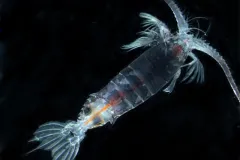Five Questions with Russ Hopcroft, Zooplankton Whiz

Now that the Census of Marine Life is over, we’re checking in with some of its researchers to hear about their favorite expeditions, what they learned, and how the Census and its findings continue to influence their work.
 Russ Hopcroft is a biological oceanographer at the Institute of Marine Science at the University of Alaska Fairbanks who studies zooplankton. During the Census, he was the Principal Investigator for the Arctic Ocean Diversity Project, which studied life throughout the Arctic Ocean. He also was involved with the Census of Marine Zooplankton and took many beautiful pictures of tiny plankton during the study.
Russ Hopcroft is a biological oceanographer at the Institute of Marine Science at the University of Alaska Fairbanks who studies zooplankton. During the Census, he was the Principal Investigator for the Arctic Ocean Diversity Project, which studied life throughout the Arctic Ocean. He also was involved with the Census of Marine Zooplankton and took many beautiful pictures of tiny plankton during the study.
What do you study?
I study mostly the small animals called plankton that drift around in the oceans. They are primarily multicellular, and primarily small: most of them are things that you have trouble seeing with your naked eye under the microscope. But some plankton can be big, like certain jellyfish that are several meters long. The defining feature of plankton is that they can’t fight against the currents and decide where they want to go—they really are drifters.
When we study these communities, it’s important to identify the animals making them up correctly. I study all the way from the simple end, when I go collect them from the ocean and then figure out who’s there, how many of them there are, and how much they weigh. At the other end, I study processes: how fast they grow, how communities fit together, and who’s important in the system. And then I do a lot of imaging as well.
How did you end up being an expert on zooplankton?
A lot of this is coincidence. You go to university and decide to work on the oceans and there’s a large degree of chance as to what opportunities you’re presented with, who you work with and what you end up doing. Certainly compared to what people think of as animals, a lot of the stuff that I study is strange. Zooplankton don’t follow the same rules as terrestrial animals. There’s huge diversity in the way they look and the way they feed, hunt, and camouflage themselves. And the fact that they are something different makes them more intriguing because the images are often unexpected. They’re things you didn’t often know existed.
What was the best part of the Census?
The strength of the Census is that it formed groups of people that would not naturally be working together closely. Through those collaborations, we were able to pull our data together into one place and see a bigger picture than any of us would have seen individually. Partly through the work with the Census, we were able to better define diversity in the Arctic and the major structuring elements of that diversity. The Census to a large degree was trying to establish a baseline of what we know and, with a few exceptions, wasn’t trying to explain how things are changed. Now that we’ve got that baseline started, the next step is to set up programs that will allow us to study change.
What was the most interesting thing you learned from the Census?
I was ultimately surprised at the degree of diversity in deep water in the Arctic Ocean. In some ways, it wasn’t that surprising: there was a lot of possibility for species discovery in the deep Arctic because many organisms that live down there are hard to collect because they’re rare or fragile. The hardest zone to study in the deep sea is the deep water right above the bottom because seafloor people can’t reach it, and open water people (like me) don’t want to accidentally run our gear into the mud! Some organisms that live in that layer don’t tend to be found outside of it, and we really don’t appreciate them as much as we should.
How does the Census continue to impact your work?
I think much more broadly than how I did before the Census. I’m much more aware of how things fit together into bigger picture ideas. The Arctic Census research has kind of evolved into a new project in the Arctic now: the Circumpolar Biodiversity Monitoring Program, which is organized by the major Arctic nations. The intent of that group is to report on the state of the ecosystem and try to coordinate the research being done by the various Arctic nations so we can begin to look at questions of climate change.

